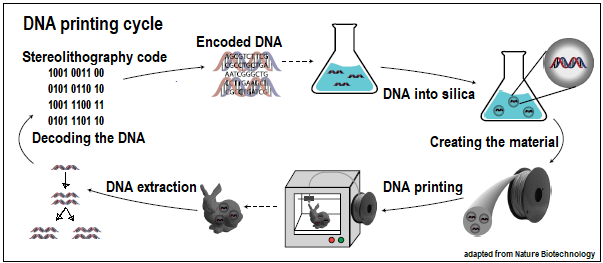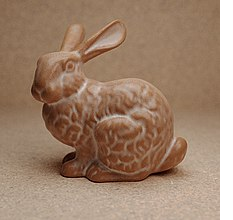Can artificial materials contain the code to create copies of themselves? asks S.Ananthanarayanan.
The hallmark of living things is cell division, where a cell becomes two cells and each daughter cell is the same as the parent. And then, living cells contain the intelligence to arrange themselves so that a cell can grow into a copy of the parent organism.
Julian Koch, Silvan Gantenbein?, Kunal Masania??, Wendelin J. Stark, Yaniv Erlich? ? and Robert N. Grass, from Zurich in Switzerland and Raanana, in Israel, write in the journal, Nature Biotechnology, that they have embedded the code for the shape of ? the Stanford bunny, a model object in the field of 3D printing, into the material of the bunny, so that the bunny can be rebuilt with the help of a speck of its own material.
Of course, this is not nature’s way of cell division and spontaneous reconstruction. It is, however, the use of the technology that resides in living cells for the material of an object to contain the blueprint for the object’s own reconstruction.
An early way of reproducing shapes was the tracer lathe, where the cutting tools were guided by a stylus that moved along a template. A development was the CNC, or Computer Numerical Controlled machine, where a blueprint was converted into numbers that guide the cutting or grinding tools. With refinement, many 3-dimensional objects can now be shaped from a block of material with the help of a program that directs what parts will be chipped away.
This is clearly unlike how living things are shaped by nature. In nature, things are built up from a microscopic beginning, by adding material, to build it up, rather than chipping material away, to reduce to the shape. But now, with special materials and computer programs, this has also become possible, the process of 3-D Printing.
In the case of a 2-D object, like a picture, a scanner extracts the information of the colour and brightness at each location on the picture, and stores the information in digital form. The stored information can then be used to reproduce the picture, on a screen or through a printer. In 3-D printing, a 3-D object is scanned in the same way, to generate a set of numbers that contain the shape information of the object. With this information, a computer controlled machine deposits layers of material according to the shape that has been recorded, to build up a replica of the original object. The process may be faster and more economical than coming down to the shape from a larger block of material, and would certainly be less wasteful.
Nature also builds organisms up by adding cells, from a single celled beginning. Here, however, the growth is not be external deposition, but by building cells up from the substances in the environment, with the help of a program of construction that the cells contain. This program is the DNA, the record that is there in the nucleus of every cell.
When the cell replicates, the DNA splits into two complementary halves and the halves become two separate wholes by rebuilding their missing counterpart halves. The new cells hence have the DNA, with instructions that decide the structure and function of the cell, as well as instructions that tell the cell when and how, in turn, to replicate
In this way, a living organism is able build itself and to reproduce. A significant aspect of the process, however, is that a very complex set of instructions, all that is needed for the functioning of a living animal, is encoded in every cell, so that the instructions are available everywhere, and all within the microscopic nucleus of the cell. And, in an artificial system, even if the whole process of natural growth and reproduction is not feasible, so far, the work reported in Nature Biotechnology represents an important application of DNA storage and retrieval, albeit in a different context
A number of fields are now looking at using DNA for data storage. While data from programmes like space exploration or CERN’s Large Hadron Collider is processed over months in dedicated facilities or through crowd sourcing, there is very huge data that needs to be preserved. Records like civil documents, like land records, topographic data, layout of drainage or communication lines have become massive and need to be preserved in digital formats. There is thus need for huge capacity and very reliable and stable, long term storage.
The microscopic DNA, clearly, has the greatest capacity, and great economy of space. As for durability, we have instances of the genome of animals long extinct being found preserved in fossilized remains. DNA technology for data preservation could hence be the solution of choice.
Getting hold of sufficiently long DNA backbones, on which to code digital data, however, has not been an easy task. A decade ago, the Microsoft Corporation engaged a California based company, called Twist Bioscience to supply ten million DNA strands to try out the medium. Using the currently available DNA Strands the current study developed a concept of ‘DNA of Things’, where the information of the form of a 3-D object was recorded over 12,000 units of the DNA. The information for the model object used, the Stanford Bunny, comes to 100 kilo bytes, which is some four times the size of text data in this article. With a compression technique, this was reduced to 45 kb. And then, the technique to transfer the information to the DNA strands allowed the data to be recorded more than five times over.
While DNA molecules can be freely twisted and crumpled, they would denature in heat and moisture when material for the construction of a model is prepared. The DNA was hence embedded in silica nanoparticles, called Silica Particle Encapsulated DNA (or SPED). Even with some loss of information, the five-fold redundancy in the encoding ensured that full data was available. The SPED was then combined in the material used in 3-B printing or casting, so that the DNA strands remained intact.
The process that followed is shown in the picture. The code that is used for 3-D printing the object is first encoded onto the DNA strands. These are then embedded in silica nanoparticles, to create SPED. SPED is then mixed into the material to be used for building the object, and the object is 3-D printed.
Now is where extracting the code from the object itself starts. As the material of the 3-D printed object contains silica nanoparticles, which contain DNA, a sliver that is chipped off from the 3-D printed object would contain DNA, from which the embedded code could be extracted. DNA that contains the code could then be generated in quantity and again embedded in silica nanoparticles, etc., to result in a second-generation DNA printed object.

A sliver could then be chipped off this object and the procedure repeated, to create a third-generation object. The authors of the paper report that they were able to go to five generations without loss of accuracy in the replications.
In the same way, the team was also able to encode and encapsulate the information for 1.4 MB video in a Plexiglas spectacle lens and retrieve the video from a tiny piece of the lens. “DoT could be applied to store electronic health records in medical implants, to hide data in everyday objects (steganography) and to manufacture objects containing their own blueprint. It may also facilitate the development of self-replicating machines,” the paper says.
The Stanford bunny is a ceramic model of a rabbit whose form has been broken down into 69,451 triangles, using 3-D scanning.
The set of data is widely used for testing techniques or algorithms that are used for data compression or rebuilding the original from the data
It is part of a repository of computer graphics resources at the Stanford University

------------------------------------------------------------------------------------------ Do respond to : response@simplescience.in-------------------------------------------